No, renewables don't need expensive backup power on today's grids
Posted on 17 February 2025 by Guest Author
This is a re-post from The Climate Brink by Andrew Dessler
“But what about when the sun doesn't shine?!”
Ah yes, the energy debate’s equivalent of “The Earth is flat!” Every time someone mentions solar or wind power, some self-proclaimed energy expert emerges from the woodwork to drop this supposedly devastating truth bomb: “Sure, renewables are cheap... until you need backup power for those cloudy, windless days. Factor in those costs, and suddenly fossil fuels are looking pretty sexy again!”
takes deep breath
Let me explain why this ironclad logic is as scientifically sound as claiming the Earth isn’t warming because it got cold last winter. Not only is the argument wrong — it's so fundamentally wrong that it reveals a complete misunderstanding of how modern power grids work.
Load vs. net load
Let’s start by imagining a grid that runs entirely on fossil fuels. As an example, here is the Electric Reliability Council of Texas (ERCOT) power load on Aug. 24, 2024:
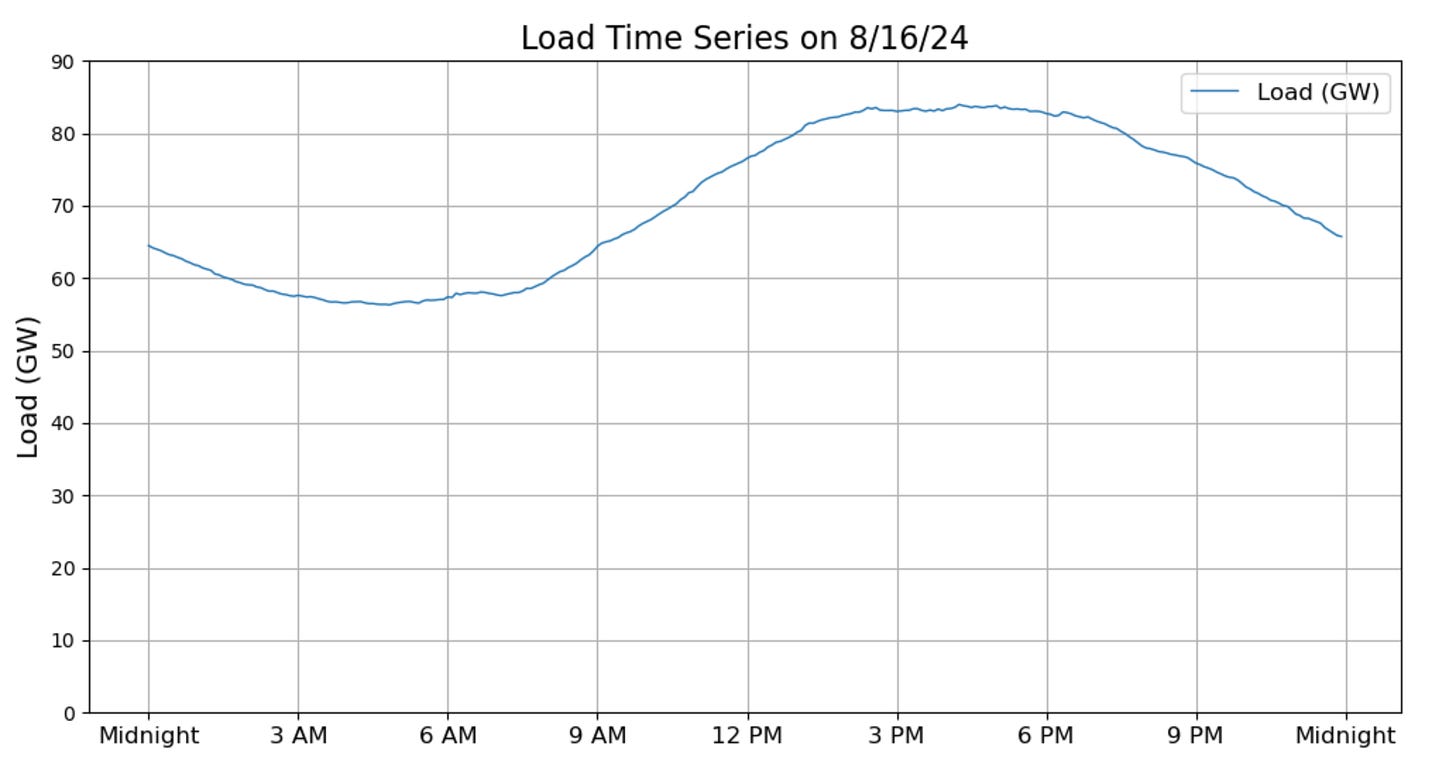
On a fully fossil-fuel grid, fossil-fuel generators would continuously adjust their output to match total load, which rises in the morning as people wake up, increases through the day with air conditioning use, peaks in the early evening, and declines overnight.
Now, let’s look at how renewable energy changes this picture. On this day in 2024, renewable sources provided about 25% of the electricity load. But unlike fossil fuel plants that can adjust their output on command, renewable generation changes throughout the day with the availability of wind and sunlight.
This is where an important concept comes in: net load. Net load represents the amount of electricity that fossil fuel plants need to provide, and we calculate it by subtracting renewable energy production from the total electricity demand. For example, if at noon the total demand is 75 GW and solar panels are generating 25 GW, the net load would be 50 GW — that's what the fossil fuel plants need to supply.
The pattern of net load throughout the day is therefore shaped both by how much electricity people are using and how much renewable energy is available at any given moment. This combined pattern is what fossil fuel power plants must track and match with their generation.
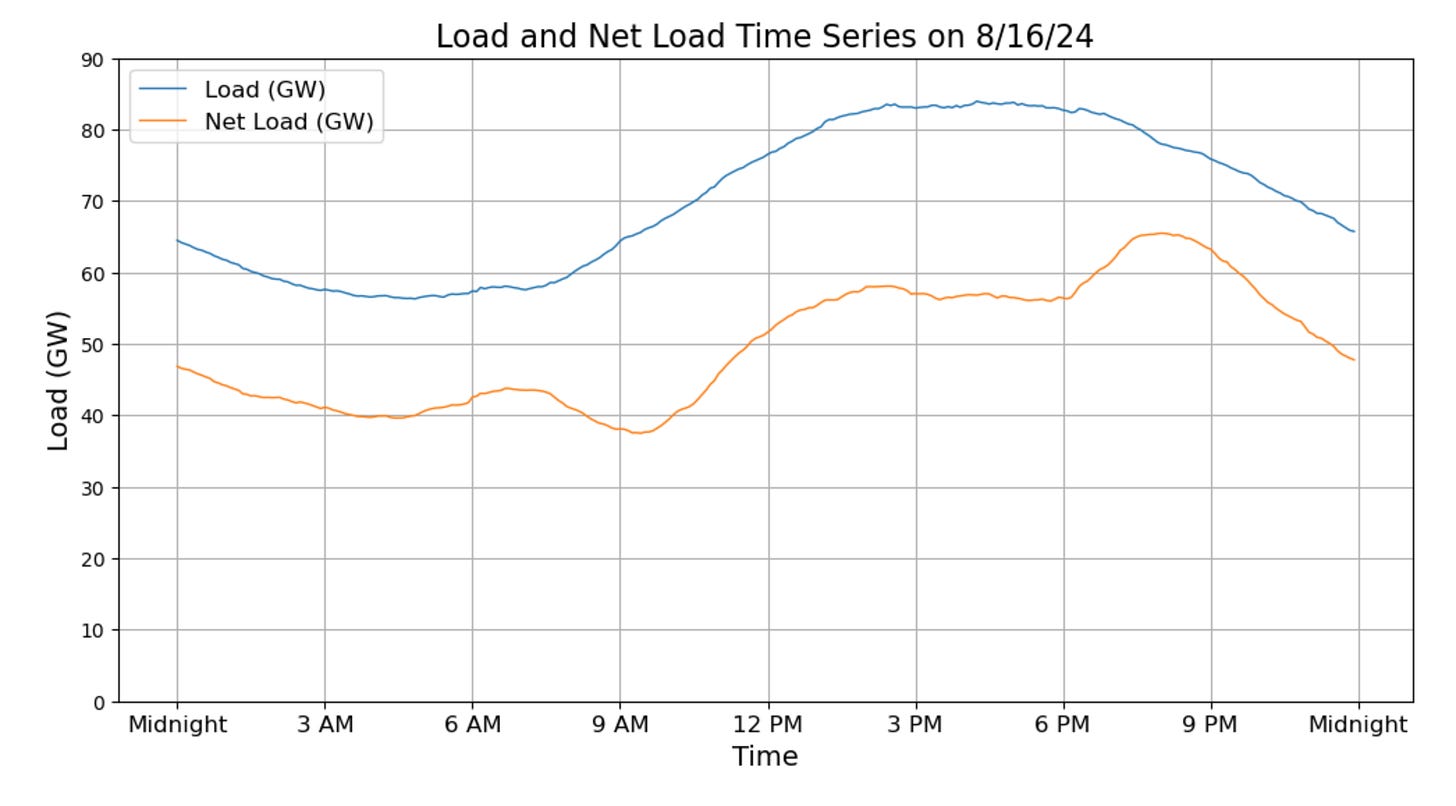
The misleading “backup” claim
We can now see that the ‘backup power’ argument misses a crucial point about modern grid operations: flexibility is already baked into the system. When renewables enter the picture, the existing fossil fuel generator fleet shifts from following total load to following net load.
This transition actually improves grid economics by reducing the usage of the most expensive power plants. The result? Lower operating costs — without any need for new backup infrastructure.
In fact, as you add renewable energy to the grid, it pushes the most expensive generators off the generator stack, eventually causing them to run so few hours that they shut down.
So the story is exactly the opposite of what critics claim: rather than demanding expensive new backup systems, renewable energy actually pushes the most costly power plants into retirement, lowering the overall cost of operating the grid. This is how renewable energy helps reduce electricity costs for consumers.
What actually controls the cost of electricity on the Texas market?
Let me be clear: It’s not the amount of renewables. The graph below shows the ERCOT retail price of electricity (horizontal axis) and the percentage of electricity coming from renewable sources (wind plus solar, vertical axis), from 2010-2023. If the claim that “renewables make electricity more expensive” were true, we would expect to see prices rising with renewable percentage increases.
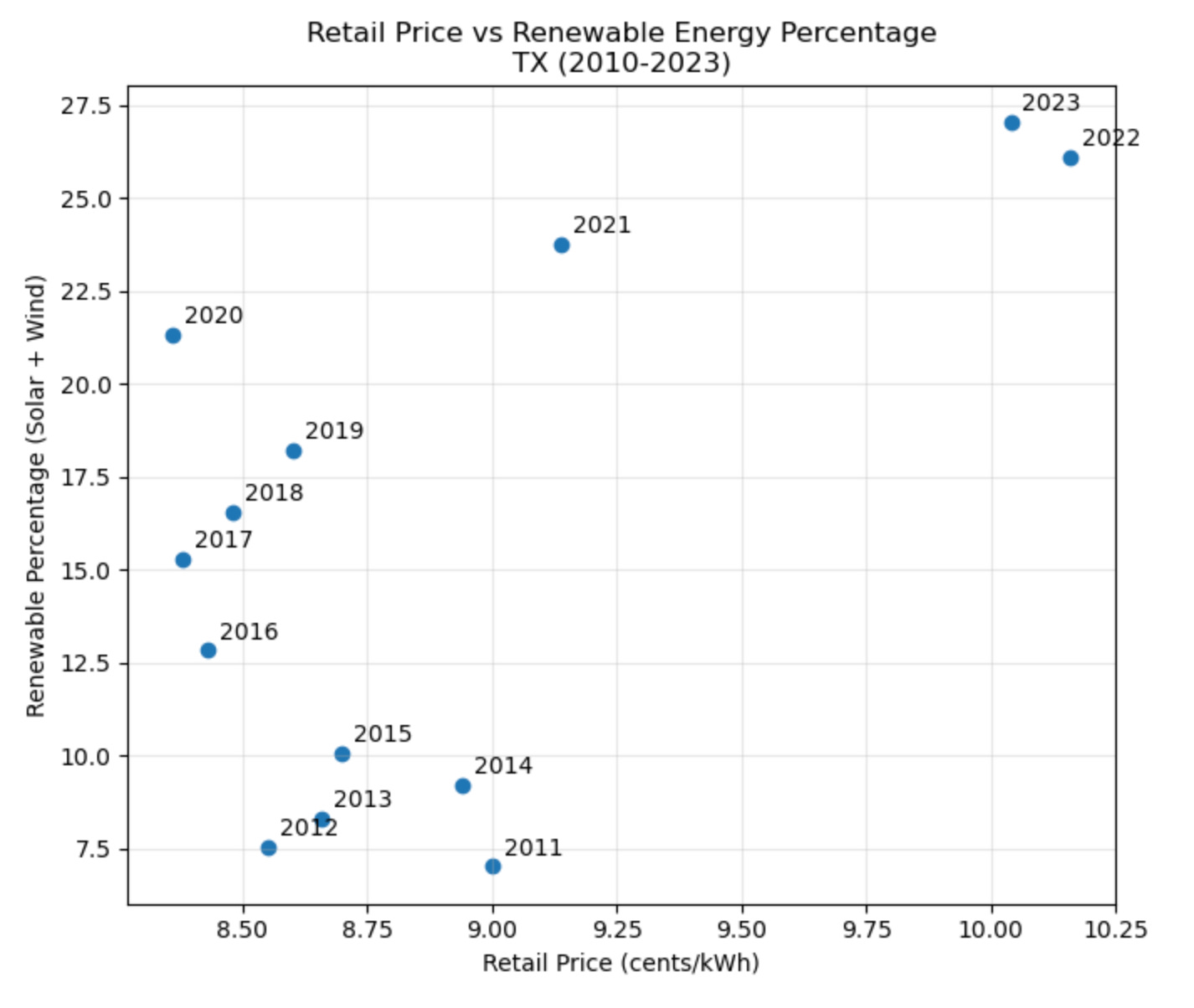
However, the data show no such relationship. If anything, the data suggest that, over most of this period, Texas maintained consistent electricity prices while adding huge amounts of renewables, demonstrating that the transition to renewable energy can be accomplished without burdening consumers with higher costs.
So what does control the price of electricity? Take a look at this plot:
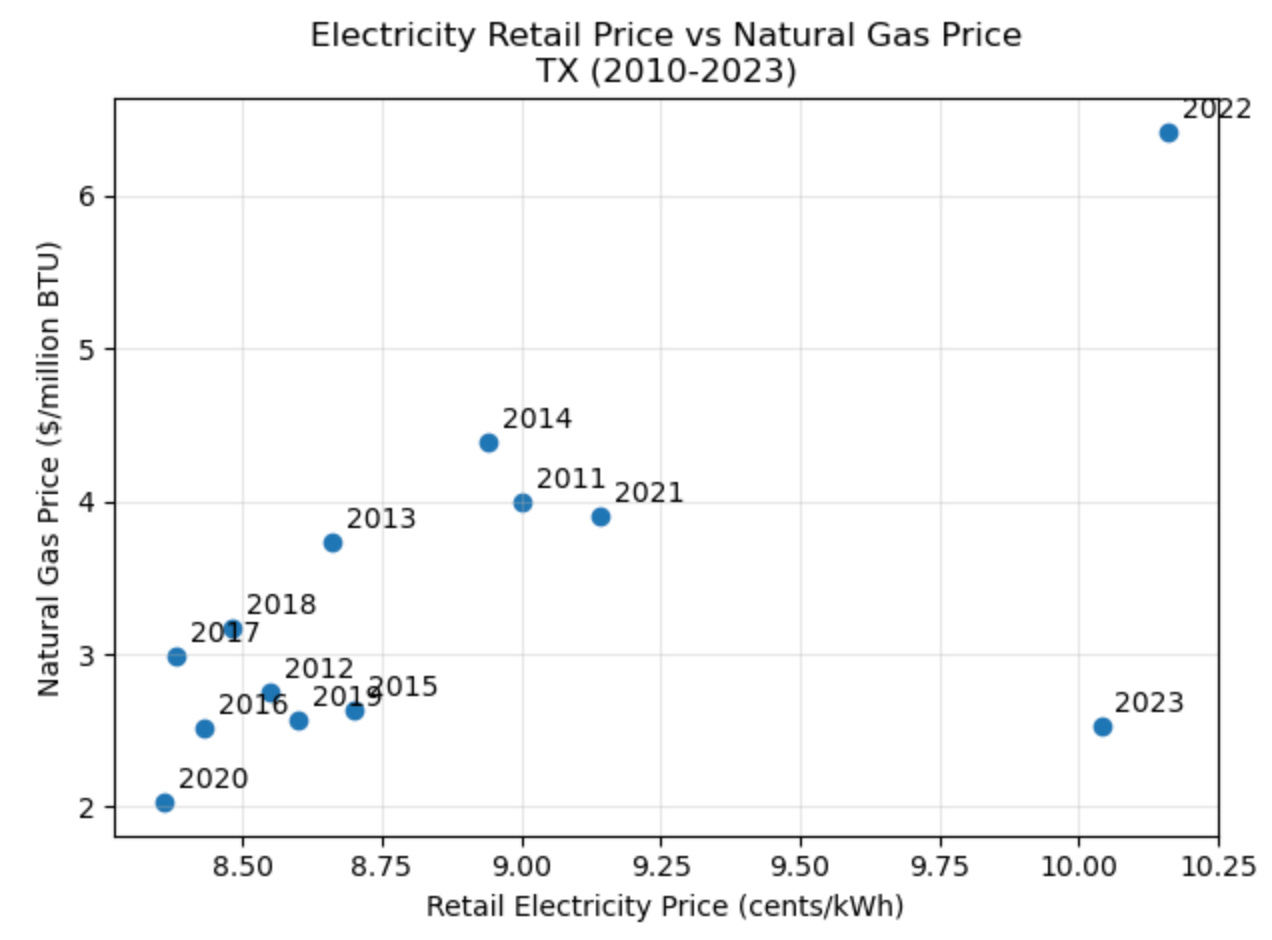
This graph reveals that the price of natural gas is strongly correlated with the cost of electricity on the ERCOT market. This makes sense because natural gas power plants are almost always the marginal generators, thereby acting as the “price-setter” for wholesale electricity. This once again confirms that renewables are not increasing the cost of electricity in this market — it’s natural gas.
This comparison also emphasizes another benefit of renewables: it protects consumers from price volatility. Unlike natural gas, which has highly variable fuel costs that directly impact electricity prices, renewable energy has zero fuel costs once the infrastructure is built. Therefore, a market whose price is set by renewables will not see the large price fluctuations that we see in grids dominated by fossil fuels.
What’s the deal with 2023? The data point for 2023 shows how extreme weather can override normal ERCOT market dynamics. While natural gas prices had fallen significantly from its 2022 peak, annual average electricity prices in Texas remained elevated due to an unprecedented heat wave in summer 2023 that strained the grid to its limits.
During those extreme conditions and the very high demand that accompanies it, ERCOT implemented scarcity pricing — a market mechanism that allows electricity prices to rise dramatically when demand approaches the grid’s capacity. The high prices are supposed to encourage large consumers to reduce their power usage and helps prevent blackouts. As a result, even though natural gas was relatively cheap, retail electricity prices stayed high because of this artificial scarcity signal.
Thus, renwable energy is presently saving the economy money by pushing expensive fossil fuel generators out of the market. Full stop.
Note that this discussion applies to today’s grids, which are mostly powered by fossil fuels (e.g., Texas is 30% renewable, with fossil fuels making up about most of the rest). As grids approach 100% renewable energy, the economics and requirements of the grid changes. I will talk about that in a future post.































 Arguments
Arguments





























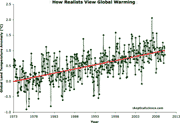
Very informative article with lots of good talking points to use with your cranky uncle!
I'm not an expert on anything but this site has expanded my knowledge base dramatically. My purpose here is to thank you for providing information such as this. Arguing about science is a lot more effective if you know the science.
Intersting - but what hppens when demand for electricity exceeds total generating capacity?
The article notes that as renewable capacity increases, the most expensive fossil fuelled generators are no longer used. It follows that as the capacity of cheaper renewable generators expands, more epxensive fossil fuelled generators cease to be competative and cease to operate - unless subsidised by Government.
The more reliant we become on renewable generators the more we will need to be assured of continuity of supply provided by back-up generating capacity and/or energy storage. Back-up is presently provided by gas generatorts, because they have rapid start-up but increasingly by cheaper, though more limited battery storage which also has ability to maintain grid stability.
@Riduna
There are different ways to achieve enough generating capacity for times, when renewables are low.
1. simply bear the possibility of very high prices in cases of scarcity. These prices could make it profitable to have generators, which are very rarely used. The overall prices can still be low as high prices are rare.
2. Some capacity market: back-up power is paid for staying or load is paid for being able to reduce demand in case of scarcity.